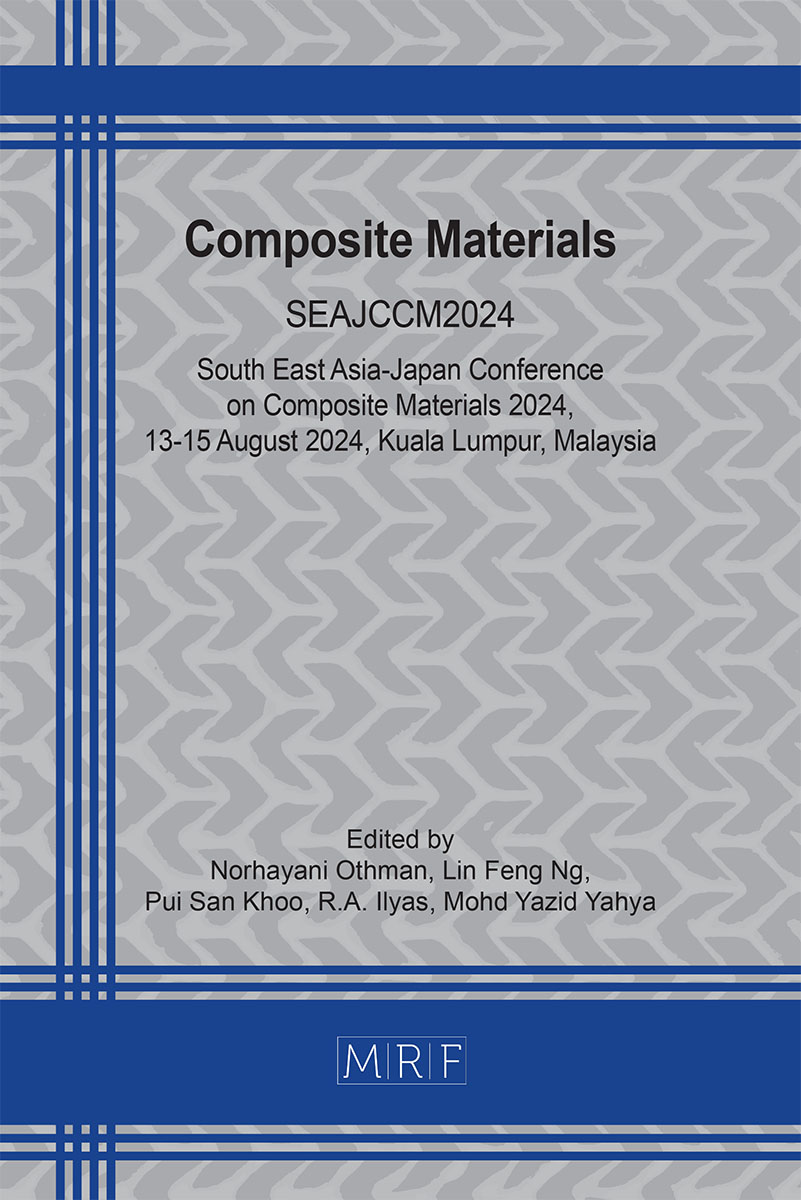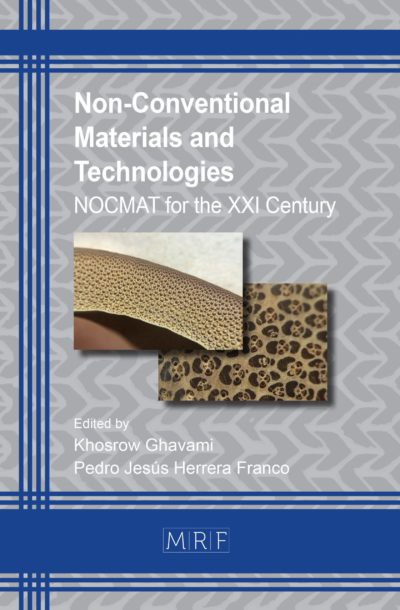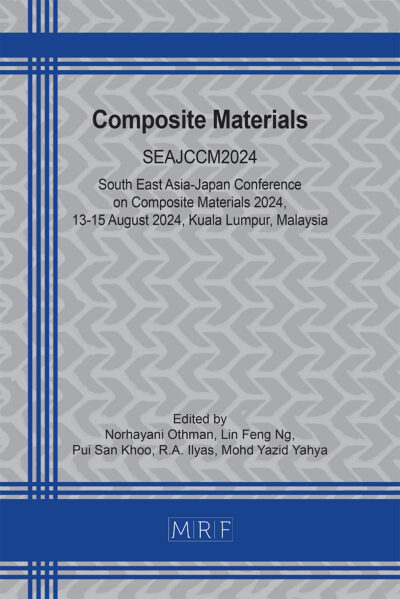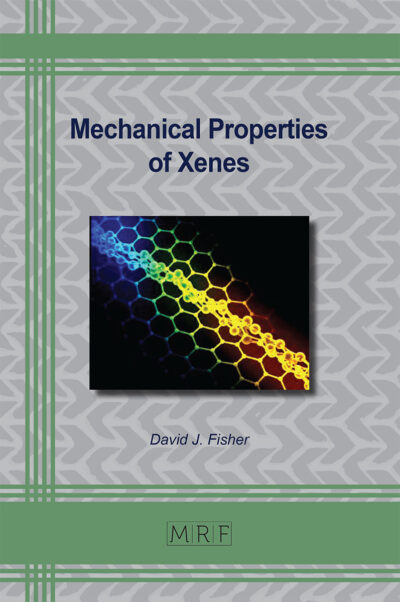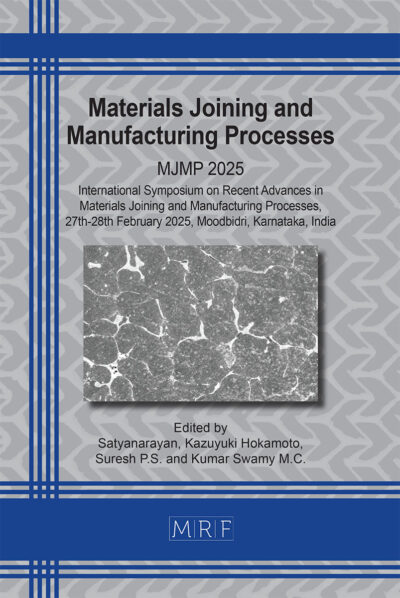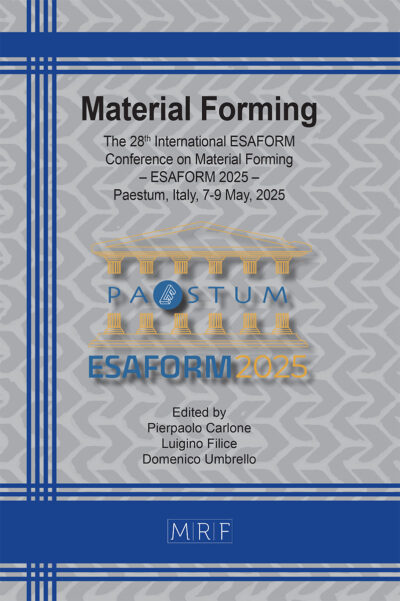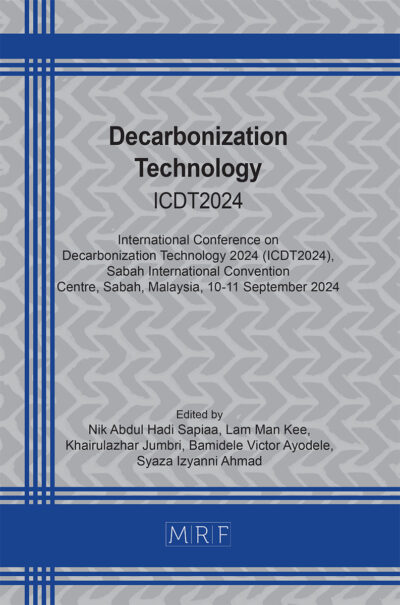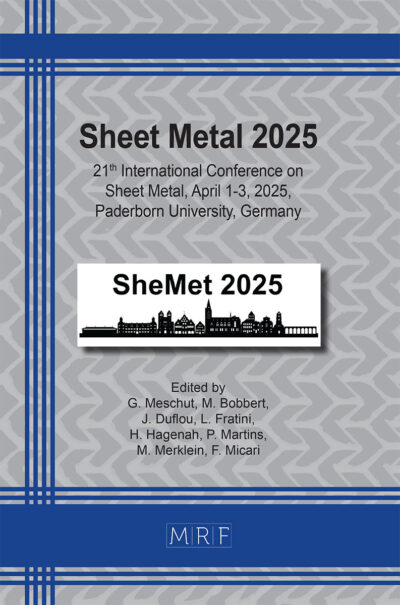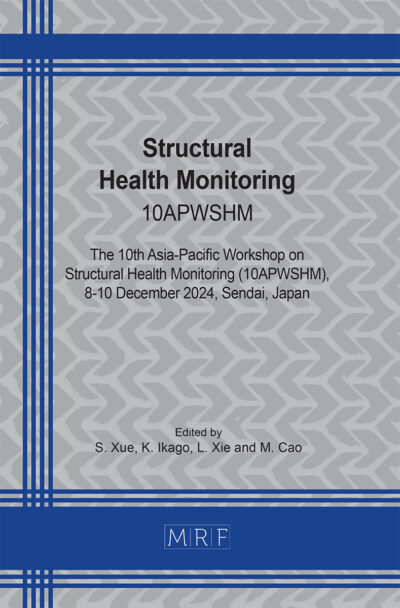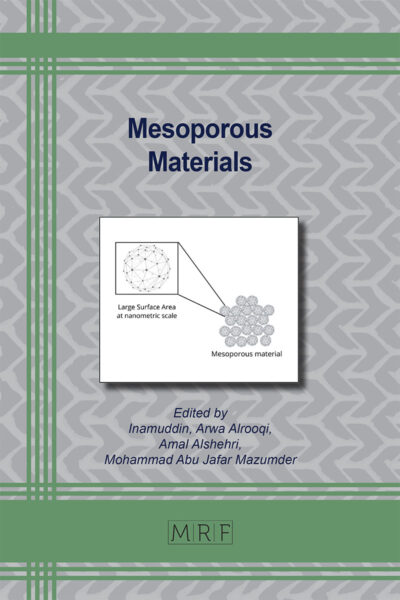A Review of Reactivity of Precursor in Manufacturing Non-Fired Clay Brick
Jun-Jian KOO, Mohammad Zawawi ROSMAN, Chee-Ming CHAN, Noor Khazanah A RAHMAN, Salina SANI, Nur Faezah YAHYA
Abstract. Geopolymer is a product of aluminosilicate materials with a strongly alkaline solution mixture, curing it at a low or slightly high temperature. Because of its low energy consumption and low carbon emissions, clay brick is recognised as a green, sustainable construction material. It is formed by three main stages of the geopolymerisation process: the dissolution of aluminosilicate materials, the nucleation growth and polymerization of monomers, and the reorganisation and polycondensation of those monomers. However, there is one critical element that should be noted, which is the reactivity of the precursor, which will affect the overall geopolymerisation process and also the final product, geopolymer. There are four factors that will affect the reactivity of a precursor: chemical composition, glass phase content, morphology, and mineralogy. If there is an issue with the low reactivity of a precursor, there are three techniques, which are thermal, chemical, and mechanical treatment, to transform it into high reactivity properties. In conclusion, with respect to the manufacturing of geopolymer bricks, also called non-fired clay bricks, the properties of the precursor in terms of reactivity should be considered in order to achieve the desired properties in the construction field.
Keywords
Geopolymerisation, Non-Fired Brick, Precursor, Strength, Reactivity
Published online 2025/06/01, 9 pages
Copyright © 2025 by the author(s)
Published under license by Materials Research Forum LLC., Millersville PA, USA
Citation: Jun-Jian KOO, Mohammad Zawawi ROSMAN, Chee-Ming CHAN, Noor Khazanah A RAHMAN, Salina SANI, Nur Faezah YAHYA, A Review of Reactivity of Precursor in Manufacturing Non-Fired Clay Brick, Materials Research Proceedings, Vol. 56, pp 21-29, 2025
DOI: https://doi.org/10.21741/9781644903636-3
The article was published as article 3 of the book Composite Materials
![]() Content from this work may be used under the terms of the Creative Commons Attribution 3.0 license. Any further distribution of this work must maintain attribution to the author(s) and the title of the work, journal citation and DOI.
Content from this work may be used under the terms of the Creative Commons Attribution 3.0 license. Any further distribution of this work must maintain attribution to the author(s) and the title of the work, journal citation and DOI.
References
[1] M. Sumesh, U.J. Alengaram, M.Z. Jumaat, K.H. Mo, M.F. Alnahhal, Incorporation of nano-materials in cement composite and geopolymer based paste and mortar A review, Construction and Building Materials 148 (2017) 62-84. https://doi.org/10.1016/j.conbuildmat.2017.04.206
[2] Mucsi, Gábor, M. Ambrus. MultiScience – XXXI (2018). https://doi.org/10.26649/musci.2017.008
[3] S. Iftikhar, K. Rashid, E.U. Haq, I. Zafar, F.K. Alqahtani, M.I. Khan, Synthesis and characterization of sustainable geopolymer green clay bricks: An alternative to burnt clay brick, Construction and Building Materials 259 (2020) 119659. https://doi.org/10.1016/j.conbuildmat.2020.119659
[4] D. Muheise-Araalia, S. Pavia, Properties of unfired, illitic-clay bricks for sustainable construction, Construction and Building Materials 268 (2021) 121118. https://doi.org/10.1016/j.conbuildmat.2020.121118
[5] M. Zhang, H. Guo, T. El-Korchi, G. Zhang, M. Tao, Experimental feasibility study of geopolymer as the next-generation soil stabilizer, Construction and building materials 47 (2013) 1468-1478. https://doi.org/10.1016/j.conbuildmat.2013.06.017
[6] T. Ye, J. Xiao, Z. Duan, S. Li, Geopolymers made of recycled brick and concrete powder – A critical review, Construction and Building Materials 330 (2022) 127232. https://doi.org/10.1016/j.conbuildmat.2022.127232
[7] L.N. Tchadjie, S.O. Ekolu, Enhancing the reactivity of aluminosilicate materials toward geopolymer synthesis, Journal of materials science 53 (2018) 4709-4733. https://doi.org/10.1007/s10853-017-1907-7
[8] S. Luhar, I. Luhar, D. Nicolaides, R. Gupta, Durability performance evaluation of rubberized geopolymer concrete, Sustainability 13 (2021) 5969. https://doi.org/10.3390/su13115969
[9] A. Nikolov, I. Rostovsky, H. Nugteren, Geopolymer materials based on natural zeolite. Case Studies in Construction Materials 6 (2017) 198-205. https://doi.org/10.1016/j.cscm.2017.03.001
[10] R. Mohamed, R. Abd Razak, M.M.A.B. Abdullah, R.K. Shuib, J. Chaiprapa, Geopolymerization of class C fly ash: reaction kinetics, microstructure properties and compressive strength of early age, Journal of Non-Crystalline Solids 553 (2021) 120519. https://doi.org/10.1016/j.jnoncrysol.2020.120519
[11] L. Hou, J. Li, Z.Y. Lu, Effect of Na/Al on formation, structures and properties of metakaolin based Na-geopolymer, Construction and Building Materials 226 (2019) 250-258. https://doi.org/10.1016/j.conbuildmat.2019.07.171
[12] C.R. Kaze, S.B.K. Jiofack, Ö. Cengiz, T.S. Alomayri, A. Adesina, H. Rahier, Reactivity and mechanical performance of geopolymer binders from metakaolin/meta-halloysite blends, Construction and Building Materials 336 (2022) 127546. https://doi.org/10.1016/j.conbuildmat.2022.127546
[13] M.I. Morsy, K.A. Alakeel, A.E. Ahmed, A.M. Abbas, A.I. Omara, N.R. Abdelsalam, H.H. Emaish, Recycling rice straw ash to produce low thermal conductivity and moisture-resistant geopolymer adobe bricks, Saudi Journal of Biological Sciences 29 (2022) 3759-3771.
[14] U. Ghani, S. Hussain, M. Imtiaz, S.A. Khan, Role of calcination on geopolymerization of lateritic clay by alkali treatment, Journal of Saudi Chemical Society 25 (2021) 101198. https://doi.org/10.1016/j.jscs.2021.101198
[15] M. Ahmad, K. Rashid, Novel approach to synthesize clay-based geopolymer brick: Optimizing molding pressure and precursors’ proportioning, Construction and Building Materials 322 (2022) 126472. https://doi.org/10.1016/j.conbuildmat.2022.126472
[16] K.Z. Farhan, M.A.M. Johari, R. Demirboğa, Assessment of important parameters involved in the synthesis of geopolymer composites: A review, Construction and Building Materials 264 (2020) 120276. https://doi.org/10.1016/j.conbuildmat.2020.120276
[17] C.R. Kaze, A. Adesina, G.L. Lecomte-Nana, H. Assaedi, T. Alomayri, E. Kamseu, U.C. Melo, Physico-mechanical and microstructural properties of geopolymer binders synthesized with metakaolin and meta-halloysite as precursors, Cleaner Materials 4 (2022) 100070. https://doi.org/10.1016/j.clema.2022.100070
[18] J. Bensted, P. Barnes, Structure and Performance of Cements, New York: Spon Press, 2002. https://doi.org/10.1201/9781482295016
[19] N. Sedira, J. Castro-Gomes, M. Magrinho, Red clay brick and tungsten mining waste-based alkali-activated binder: Microstructural and mechanical properties, Construction and Building Materials 190 (2018) 1034-1048. https://doi.org/10.1016/j.conbuildmat.2018.09.153
[20] H.K. Tchakoute, A. Elimbi, E. Yanne, C.N. Djangang, Utilization of volcanic ashes for the production of geopolymers cured at ambient temperature, Cement and Concrete Composites 38 (2013) 75-81. https://doi.org/10.1016/j.cemconcomp.2013.03.010
[21] K. Bouguermouh, N. Bouzidi, L. Mahtout, L. Pérez-Villarejo, M.L. Martínez-Cartas, Effect of acid attack on microstructure and composition of metakaolin-based geopolymers: The role of alkaline activator, Journal of Non-Crystalline Solids 463 (2017) 128-137. https://doi.org/10.1016/j.jnoncrysol.2017.03.011
[22] H.K. Tchakouté, S. Kong, J.N.Y. Djobo, L.N. Tchadjié, D. Njopwouo, A comparative study of two methods to produce geopolymer composites from volcanic scoria and the role of structural water contained in the volcanic scoria on its reactivity, Ceramics International 41 (2015) 12568-12577. https://doi.org/10.1016/j.ceramint.2015.06.073
[23] A.Z. Khalifa, Ö. Cizer, Y. Pontikes, A. Heath, P. Patureau, S.A. Bernal, A.T. Marsh, Advances in alkali-activation of clay minerals, Cement and Concrete Research 132 (2020) 106050. https://doi.org/10.1016/j.cemconres.2020.106050
[24] H.K. Tchakoute, C.H. Rüscher, J.Y. Djobo, B.B.D. Kenne, D. Njopwouo, Influence of gibbsite and quartz in kaolin on the properties of metakaolin-based geopolymer cements, Applied Clay Science 107 (2015) 188-194. https://doi.org/10.1016/j.clay.2015.01.023
[25] D. Song, T. Huang, Q. Fang, A. Liu, Y. F. Gu, Y.Q. Liu, L.F. Liu, S.W. Zhang, Feasibility exploration on the geopolymerization activation of volcanic tuff, parametrical optimization, and reaction mechanisms, Journal of Materials Research and Technology 11 (2021) 618-632. https://doi.org/10.1016/j.jmrt.2021.01.029
[26] T. Kovářík, P. Bělský, P. Novotný, J. Říha, J. Savková, R. Medlín, D. Rieger, P. Holba, Structural and physical changes of re-calcined metakaolin regarding its reactivity, Construction and Building Materials 80 (2015) 98-104. https://doi.org/10.1016/j.conbuildmat.2014.12.062
[27] M.O. Yusuf, M.A.M. Johari, Z.A. Ahmad, M. Maslehuddin, Effects of addition of Al (OH)3 on the strength of alkaline activated ground blast furnace slag-ultrafine palm oil fuel ash (AAGU) based binder, Construction and Building Materials 50 (2014) 361-367. https://doi.org/10.1016/j.conbuildmat.2013.09.054
[28] S. Kumar, R. Kumar, S.P. Mehrotra, Influence of granulated blast furnace slag on the reaction, structure and properties of fly ash based geopolymer, Journal of materials science 45 (2010) 607-615. https://doi.org/10.1007/s10853-009-3934-5
[29] R.A. Robayo-Salazar, R.M. De Gutiérrez, F. Puertas, Effect of metakaolin on natural volcanic pozzolan-based geopolymer cement, Applied Clay Science 132 (2016) 491-497. https://doi.org/10.1016/j.clay.2016.07.020
[30] S. Saha, C. Rajasekaran, Enhancement of the properties of fly ash based geopolymer paste by incorporating ground granulated blast furnace slag, Construction and Building Materials 146 (2017) 615-620. https://doi.org/10.1016/j.conbuildmat.2017.04.139
[31] J.Y. Djobo, L.N. Tchadjié, H.K. Tchakoute, B.B.D. Kenne, A. Elimbi, D. Njopwouo, Synthesis of geopolymer composites from a mixture of volcanic scoria and metakaolin, Journal of Asian Ceramic Societies 2 (2014) 387-398. https://doi.org/10.1016/j.jascer.2014.08.003
[32] H. Xu, Q. Li, L. Shen, M. Zhang, J. Zhai, Low-reactive circulating fluidized bed combustion (CFBC) fly ashes as source material for geopolymer synthesis, Waste Management 30 (2010) 57-62. https://doi.org/10.1016/j.wasman.2009.09.014
[33] H.K. Tchakoute, A. Elimbi, B.D. Kenne, J.A. Mbey, D. Njopwouo, Synthesis of geopolymers from volcanic ash via the alkaline fusion method: Effect of Al2O3/Na2O molar ratio of soda–volcanic ash, Ceramics International 39 (2013) 269-276. https://doi.org/10.1016/j.ceramint.2012.06.021
[34] H.T. Kouamo, A. Elimbi, J.A. Mbey, C.N. Sabouang, D. Njopwouo, The effect of adding alumina-oxide to metakaolin and volcanic ash on geopolymer products: A comparative study, Construction and Building Materials 35 (2012) 960-969. https://doi.org/10.1016/j.conbuildmat.2012.04.023
[35] P. Baláž, M. Achimovičová, M. Baláž, P. Billik, Z. Cherkezova-Zheleva, J.M. Criado, F. Delogu, K. Wieczorek-Ciurowa, Hallmarks of mechanochemistry: from nanoparticles to technology, Chemical Society Reviews 42 (2013) 7571-7637. 10.1039/c3cs35468g
[36] V.V. Boldyrev, K. Tkáčová, Mechanochemistry of solids: past, present, and prospects, Journal of materials synthesis and processing 8 (2000) 121-132. https://doi.org/10.1023/A:1011347706721
[37] G. Mucsi, Mechanical activation of power station fly ash by grinding–A review, Építőanyag 68 (2016) 56-61. https://doi.org/10.14382/epitoanyag-jsbcm.2016.10
[38] I. Tole, K. Habermehl-Cwirzen, A. Cwirzen, Mechanochemical activation of natural clay minerals: an alternative to produce sustainable cementitious binders–review, Mineralogy and Petrology 113 (2019) 449-462. https://doi.org/10.1007/s00710-019-00666-y
[39] P.J. Sanchez-Soto, A. Wiewiora, M.A. Avilés, A. Justo, L.A. Pérez-Maqueda, J.L. Pérez-Rodríguez, P. Bylina, Talc from Puebla de Lillo, Spain. II. Effect of dry grinding on particle size and shape, Applied Clay Science 12 (1997) 297-312. https://doi.org/10.1016/S0169-1317(97)00013-6
[40] I. Bekri-Abbes, E. Srasra, Effect of mechanochemical treatment on structure and electrical properties of montmorillonite, Journal of Alloys and Compounds 671 (2016) 34-42. https://doi.org/10.1016/j.jallcom.2016.02.048
[41] J. Ondruška, Š. Csáki, V. Trnovcova, I. Štubňa, F. Lukáč, J. Pokorný, L. Vozar, P. Dobroň, Influence of mechanical activation on DC conductivity of kaolin, Applied Clay Science 154 (2018) 36-42. https://doi.org/10.1016/j.clay.2017.12.038
[42] A. Souri, H. Kazemi-Kamyab, R. Snellings, R. Naghizadeh, F. Golestani-Fard, K. Scrivener, Pozzolanic activity of mechanochemically and thermally activated kaolins in cement, Cement and Concrete Research 77 (2015) 47-59. https://doi.org/10.1016/j.cemconres.2015.04.017

